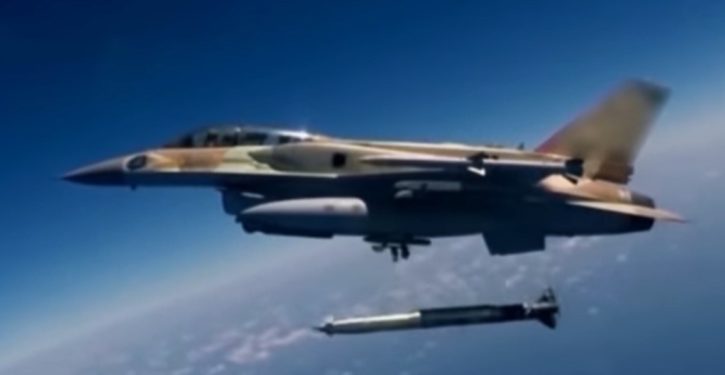
There’s a big picture here, and a bigger one.
In the last week, Russia has appeared to signal a shift in posture and intentions regarding Israel’s freedom of air operations against Iran- and Hezbollah-linked targets in Syia.
The shift is odd, if not necessarily out of character or unexpected. Its features have been peculiar. On 22 July, Russia’s state-run RT (Russia Today) media outlet reported that Syrian operators shot down air-to-surface missiles launched by Israeli strike-fighters at targets in Homs Province in Syria.
Will this presidential election be the most important in American history?
The Russian report was very specific that the Syrians had shot Israeli missiles down using the Buk (Buk-M2E) medium-range air defense missile system.
The same report claimed that Syrians also shot down seven of eight Israeli air-launched missiles from a strike on Tuesday, 20 July against targets in Aleppo Province. The report stated that the Syrians used both the Buk and Pantsir-S systems (the Pantsir-S is a medium-range integrated missile and gun system). The range point for the systems is up to about 20 statute miles depending on target altitude and type.
For each strike event, the RT report was at pains to demonstrate Russian knowledge of where the IAF launched its missiles from. The launch on Homs Province was said to be by jets over Lebanon. The launch on Aleppo – further north – was conducted by the Israelis from further south and from a different firing direction, the IAF planes having entered Syria from the At-Tanf area at the extreme western edge of the Iraqi border with southern Syria.

Then the Russian outlet Sputnik, also in the state-run media consortium, said on Sunday that Syrians had shot down more Israeli missiles aimed at a target south of Damascus. In this case Sputnik quoted Rear Admiral Vadim Kulit, deputy head of the Russian Center for the Reconciliation of Warring Parties in Syria.
According to the official, in the early hours of Sunday, two Israeli F-16 fighter jets conducted an airstrike against facilities in the Set Zaynab settlement, south of Damascus, without entering the Syrian airspace.
“Both missiles were destroyed by Russian Buk-M2E missile systems that are used by the Syrian military’s air defense forces,” Rear Adm. Vadim Kulit said.
The Sunday report did not indicate exactly where the Israeli planes were at the time of launch, but Jewish Press cites a Russian-language report claiming the 25 July launches were from “a southwesterly direction” in relation to the target.
The Jewish Press article quotes retired Brigadier General (Res.) Ram Shmueli, a fighter pilot and, before retirement, head of the air intelligence squadron, as opining that the Russians are talking up their weapon systems. Shmueli acknowledges the basic point I would make – that the shootdowns are feasible with the weapons alluded to – and at least some could have happened.
He concludes, however, that “the reality is very far from the way the Russians and Syrians try to describe it since the targets are being destroyed. The Israeli Air Force is likely overcoming the Russian capability, both by technological means and by utilizing a large killing ratio of missiles, to ensure destruction.”
It isn’t clear yet what happened at the target locations in Syria in the last week, although we can expect open source information to be posted on that at some point, based on commercial satellite imagery. For what it’s worth, I suspect Shmueli is right, and the shootdown claims are at least somewhat overblown.
But in spite of General Shmueli’s assurances, it’s definitely a more-than-marginal shift for Russia to engage in such overt messaging about countering Israel’s strikes. The overtness of it is what struck me immediately.
Seth Frantzmann followed up with a treatment in the Jerusalem Post of some remarkable communications attributed to Russian sources at the same time as the alleged missile shootdowns.
Russia making a move
Frantzmann’s opening thesis: “Russia could be moving to pressure Israel to stop airstrikes in Syria.”
An article citing one Russian source at Asharq al-Awsat (granted, not the highest-reliability outlet out there) “hinted at the possibility of ‘closing Syrian airspace’ to Israeli planes.”

Says Frantzmann: “[T]he Russian source told the Arabic website … that ‘Moscow was calculating its reactions in the past because Tel Aviv [Jerusalem] is coordinating all its movements with Washington, while the Russian communication channels with Washington were cut off, and it appeared, from the current contacts with the American side, that Moscow obtained confirmation that Washington does not welcome the continuous Israeli raids.’”
The final words suggesting Washington “does not welcome the continuous Israeli raids” have a whiff of Russian marplottery about them. But Frantzmann isn’t wrong to entertain the concern that the Biden administration, with its obsessive focus on stroking toward a JCPOA 2.0 with Iran, may prefer to see less strike-activism in Syria by the Israelis.
Frantzman leaves that hanging as a question to be answered. He also notes that Asharq al-Awsat’s “source went on to claim that Russia’s demands might involve closing off ‘all possible targets’ inside Syria. The author notes that in the past, Moscow did not object to attacks on Iranian targets in Syria. It has ‘run out of patience,’ the article said, but then also quoted the Russians as saying they are actually not impatient.”
Again, this looks on its face like Russia setting the cat amongst the pigeons, no doubt with a Cheshire grin behind its quivering paw.
But it is strikingly overt. And it’s not unbacked by capability, a point that hasn’t changed in Israel’s favor in the nearly six years since Russia set up shop to act as an air space authority in Syria and challenge U.S. dominance in the whole of the Levant and Mesopotamia.
Backstory
I commented in September 2015 that the Russian deployments then, which occurred immediately after the announcement of the JCPOA “deal,” meant the Russian contingent in Syria would be increasingly able to exercise a veto over Israeli air operations against targets in Syria.
Russia promptly issued a defiant challenge to U.S. air activity at the time. And it was some four or five months later, in early 2016, that reporting emerged of Russian air defense operators taking potshots at IAF aircraft.
That deteriorating situation didn’t slide further once Donald Trump assumed the U.S. presidency in January 2017. But the U.S. administration has changed hands again, and Russia’s infrastructure for enforcing air space compliance has remained in place, and even expanded on the margins (e.g., with advanced air superiority fighters deployed to Syria).
If the Russians are to be believed, the Syrian forces are ready now to operate their own Russian-made systems. But using tactical point-defense SAMs to shoot down incoming missiles isn’t the only capability Russia’s infrastructure is intended to create. As far back as October 2016, it was evident that Russia’s long-term intention was to achieve air space dominance across the Levant and Mesopotamia by bringing in air surveillance and anti-air missile systems and generating joint projects with Iran, Iraq, and Syria.

In 2015, Russia combined with those other nations to launch a pair of “joint information centers” in Baghdad and near Damascus, with the principal focus being to establish a joint air picture across the region. Little has been reported about that venture since Trump took office, but now is the time to expect it to revive any flagging spirit it may have been suffering from in recent years. An excellent catalyst is the prospect of the U.S. largely withdrawing from Iraq.
Russia is fully invested for the long haul in Syria, and has no intention of being dislodged from her position there. A U.S Coalition drawdown from Iraq would leave something of a vacuum in air space order and leverage, which Russia will want to fill.
Merely taking up where she left off in late 2016 would entail bringing in more radar coverage – cheaply done, if there’s no real concern about defending the radars – and probably measures like field-deploying Syrian and Russian missile systems and exercising jointly with Iran, and perhaps Iraq. (Iraq would almost certainly be willing to participate promptly at the “joint information center” level in Baghdad, if not from out in the field — where Iraqi forces have little relevant capability in any case.)
Options in 2021
Russia has gone to unusual “information” lengths to establish that her forces are tracking IAF aircraft. That’s what all the spilling the beans about where Israel launched missiles from has been about, over the past week: signaling to the ops bosses in Jerusalem, “We see you” – by implication, from takeoff in Israel to recovery at end of mission.
The corollary signal, left unspoken but clearly implied, is “We hold you at risk.”
Russia does hold the IAF at risk, even over much of northern Israel, with the S400 missile system deployed to Syria and under Russian control. From southern Syria, the S400’s interceptors can range all of Israel.

The map below prepared in 2015 shows air search coverage for Russian SAM-associated radars notionally deployed in Syria and Iraq. The purpose at the time was to demonstrate the extent of coverage of airplanes at medium altitude rather than higher altitudes, as Israeli strike aircraft need not (and probably don’t want to) ascend to higher altitudes to approach Syrian targets only a short distance away. Similar coverage saturating central and southern Iraq could be achieved with the number of deployable radars shown.
The depiction of radars in Iran was geared to the older SA-5/S200 system, but Iran began implementing the S300 in 2016. Air search coverage of western Iran is extensive now; of equal importance, Russian systems in Iran and Syria can be linked for a regional air picture, and that picture made available in Iran, Iraq (at the “JIC”) and Syria.

Expanding radar coverage into Iraq is probably not in immediate prospect, at least not from the Syrian side. Establishing surveillance from the Iranian side, and moving it closer to Syria, is probably more feasible, however. Networked systems and a common air picture from Syria to Iran would make it harder for IAF aircraft to effectively exploit coverage gaps.
Israel can count less now than 10 years ago on freedom of action in the event of a perceived necessity to conduct air strikes in Iran launched from Israel. The ability to surprise Iran from such a mission profile is significantly compromised now, even apart from quiescence on the part of Russia, or generally in the air space of Syria, Jordan, or Iraq.

But in the last week, Russia has begun sending negative signals about continued quiescence. It’s understandable that, as analyst Yochanan Visser argues, Israel might be “extremely worried” about Russia and Iran. The enlarged apparatus depicted on the maps above isn’t in place yet – but Russia’s attitude appears to be shifting, and there is little at this point to stop a prohibitive buildup of capability.
These concerns must be mitigated by a few factors, however. One is that Israel’s capabilities continue to improve, as with the relatively new Rampage supersonic air-to-surface missile (depicted in the feature image at top), which Israel unveiled in 2018 and has already used in Syria. The video down below is a dramatic portrayal by the manufacturer, Elbit Systems, but lends color to General Shmueli’s claim that the IAF is able to overwhelm the point defense systems used by the Syrians. Barrages of supersonic missiles launched from a standoff range of 100 miles put the archer outside the Buk or Pantsir system’s reach, and saturate the intercept environment with arrows.
The F-35 Adir will also help mitigate the advantages Russia gains with the S400 system, and present a tougher target to surveillance and acquisition radars than the lithe F-16.
Another factor is that Russia doesn’t actually desire to provoke a confrontation with Israel. Russia wants to divide Israel and the U.S., deter Israel in any armed approach to Iran, and position Moscow as a party that Israel must consult to seek leverage and negotiation for Israeli security concerns
Angling for a center seat for Moscow is classic Russian behavior. Putin has been seeking that center seat for the Syria and Iraq problems for the last five or six years, and to a large extent already occupies it regarding Iran whenever the U.S. has a one-note Iran policy, as is the case with the Biden administration.
In my view, that gives Israel a little breathing room – if the Bennett government can perceive and use it. This need not be a matter of merely importuning Russia or dancing to Russia’s tune, and that’s because of the remarkable developments of the last year. The obvious and most prominent one is the Abraham Accords, which are showing some staying power in spite of what amounts to disdain from the Biden administration.

A timely mission to Israel
But a recent delegation to Israel of Iranian expats who seek improved Iranian-Israeli relations may hold the promise of enhancing the Abraham Accords vector. The participants, sponsored by a U.S. group led by former foreign policy officials, visited Israel last week bearing the message of what they’re calling the “Cyrus Accords,” after the Persian monarch who supported the building of the Second Temple in Jerusalem in the 6th century B.C. and is generally regarded in the West as the defining historical figure of ancient Persian culture.
Interestingly enough, the Cyrus-Israel mission arrived in Israel on 19 July, the day before the first IAF strikes in Syria that Russia later announced as having been interdicted by Syrian shootdowns (i.e, the Aleppo Province strikes on 20 July).
Most observers are likely to view the Cyrus mission with a dismissive eye, as it involves Iranian expats and regime dissidents, led by Ahmad Batebi (now living in the U.S.), and the U.S. Institute for Voices of Liberty with participation by former U.S. officials who are not currently in office. The officials include “former Deputy National Security Advisor Victoria Coates, Tehran-born former State Department Deputy Special Envoy to Monitor and Combat Antisemitism Ellie Cohanim, former Senior Advisor to the U.S. Special Representative for Iran Len Khodorkovsky, and former National Security Council Senior Director for Strategic Assessments Adam Lovinger.”

Lovinger’s name will of course trigger memories of his removal from the NSC staff early in the Trump administration. The other prominent officials in the Cyrus party were on staff during the Trump years as well. The industry-standard reaction to their initiative, in the U.S. establishment and media, will probably range from jaundiced to contemptuous.
But it ought to be obvious at this point that there is no going back to 2016, and many things that have changed in the years since then were already starting to shift long before former President Obama left office. No one outside the Trump negotiating team foresaw even in 2019 that the Abraham Accords could be signed in 2020. But they were, and they have a material effect in 2021, perhaps even more so because the current policy in Washington is so irretrievably overbalanced. The Abraham Accords offer sane options where the Biden administration’s singlemindedness about an Iran “deal” does not.
In the current environment, I would not discount the Cyrus mission. It has the potential to do something powerful: outline a vision for relations between a de-radicalized Iran and Israel, in a way that could get buy-in from UAE and Bahrain, and make headway with key figures in Saudi Arabia and even Egypt. Its impact in Iran will probably be more encouraging to dissidents there, and problematic for the regime, than outdated conventional thinkers would give credence to.
A vision for such a framework could help shape the environment in which Russia and Israel have to make decisions over the next few years. It’s obvious that Vladimir Putin doesn’t think Biden’s all-out push for a JCPOA 2.0 is the only game in town. No one else really appears to either. Israel has a lot to worry about. But if Bennett can marshal a coherent strategic perspective from his fragmented government, Israel may not be stuck making bad deals with Russia in order to avoid worse ones.




